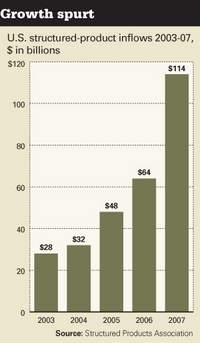Tue Apr 8, 2008 7:40pm BST
By Barani Krishnan
NEW YORK, April 8 (Reuters) - Investors are pouring money into structured investment products linked to booming commodities like oil, gold and grains, drawn to features that protect capital from the volatility common in these markets.
But the global credit crunch means the safety of capital-protected products relies upon the credit-worthiness of the issuer. That could be a concern after last month's collapse of Bear Stearns (BSC.N: Quote, Profile, Research), once the No. 5 U.S. investment bank.
Also, some financial experts caution that the risk-prevention feature in such structured products will limit investors' gains if the bull market in commodities continues.
"Managing the credit risk in the structured products environment is critical, certainly in this environment," said David Krein, president at DTB Capital, a New York firm that specializes in putting together such products for clients.
The global financial crisis linked to defaults in U.S. subprime loans already has cost banks worldwide nearly $400 billion in write-offs. Analysts see no clear end in sight to the problem, even after casualties like Bear.
"To see Bear die wasn't surprising as almost every global financial stress kills off one big bank," said Richard Kang, a Toronto-based independent risk consultant for fund management companies. "But if another big bank goes, then the market for Wall Street-backed structured products might take a whack."
The Structured Products Association, an industry group in New York, says there is about $114 billion invested in the products now, up from just around $28 billion in 2003.
Commodity-related products account for about $55 billion of the market, says Barclays Capital, the biggest issuer of such products in the United States. The rest are linked to stocks, bonds and other securities.
For the full article by Barani Krishnan, click here.
Thursday, April 17, 2008
Subscribe to:
Post Comments (Atom)




No comments:
Post a Comment